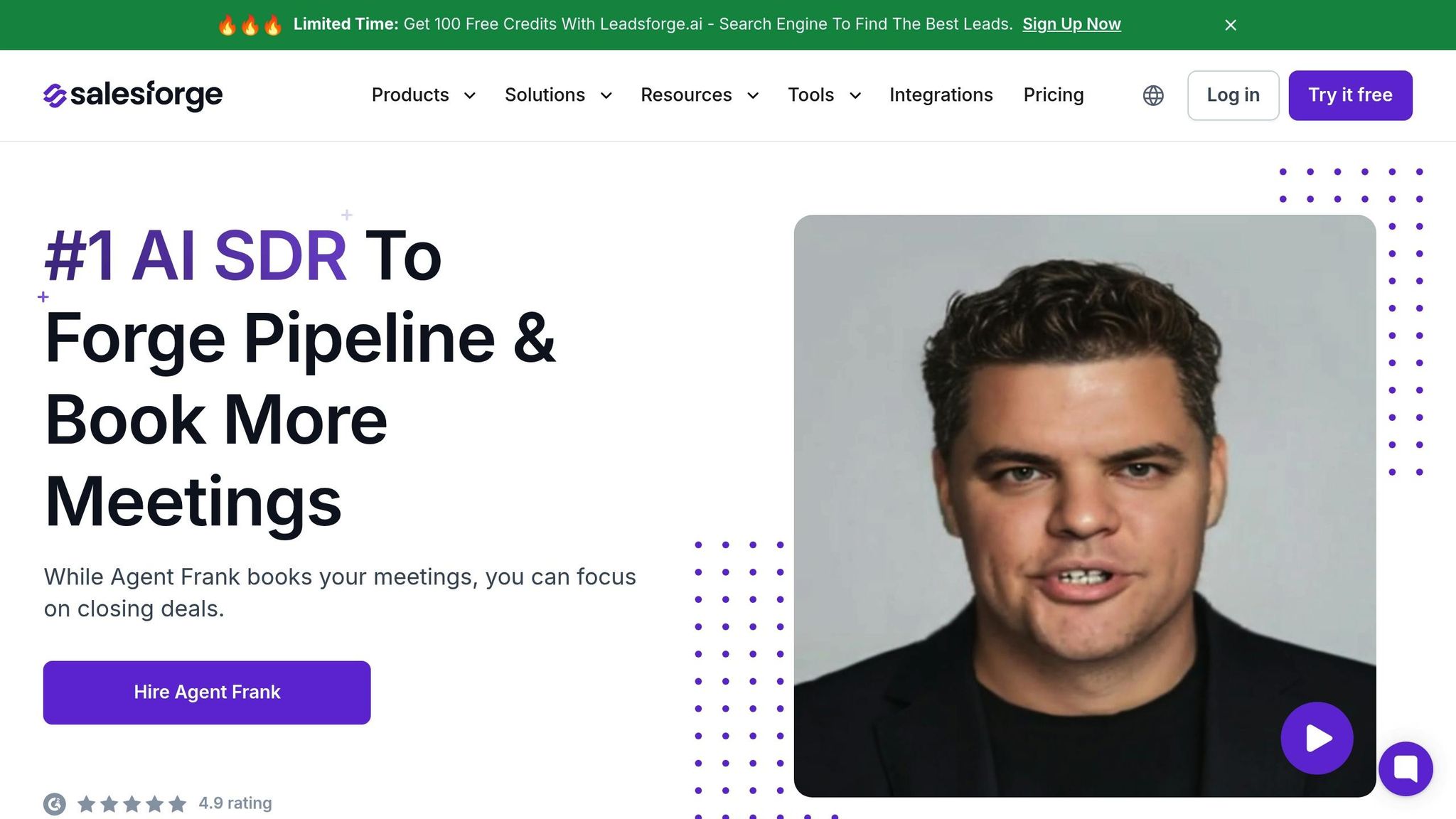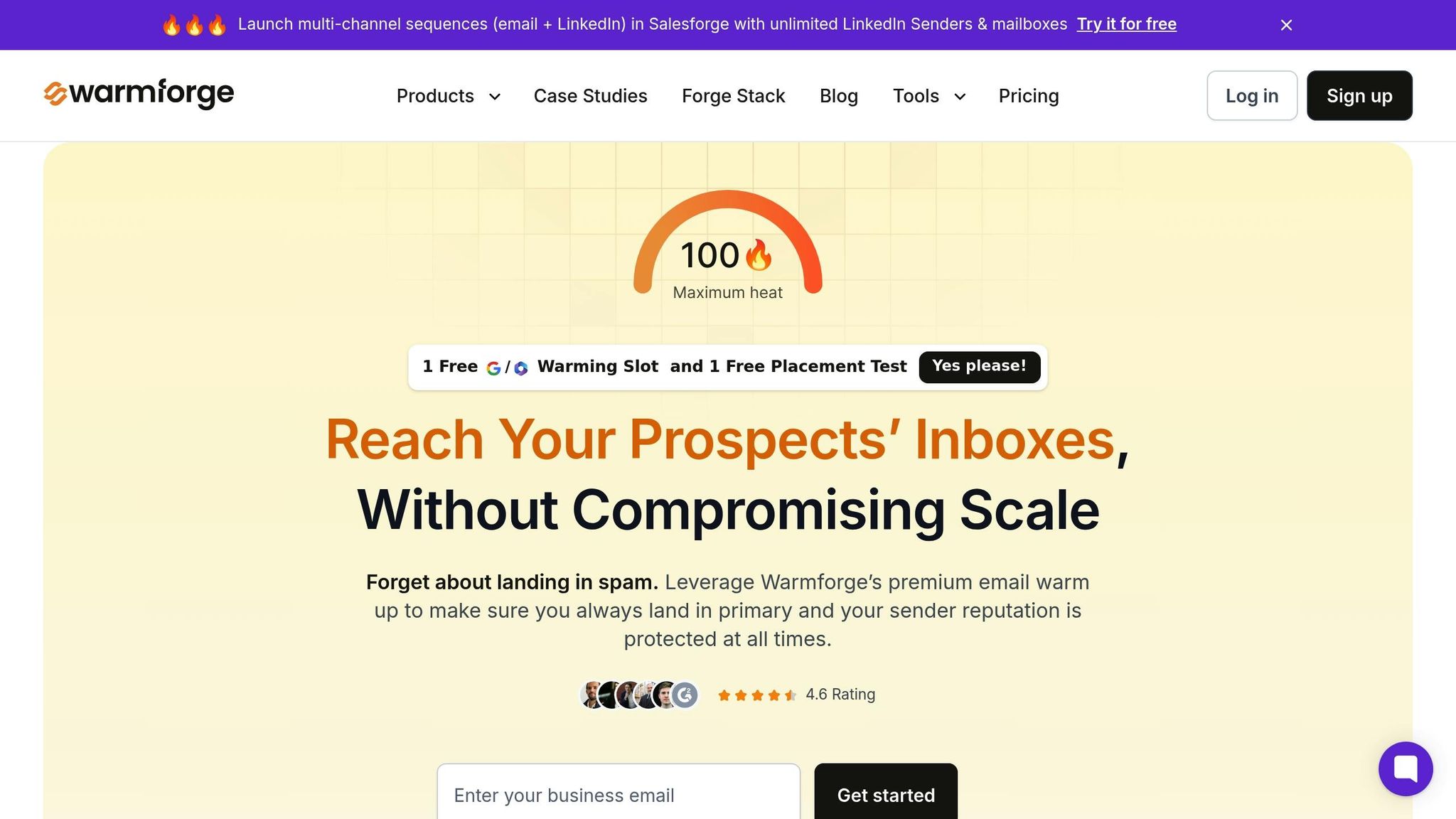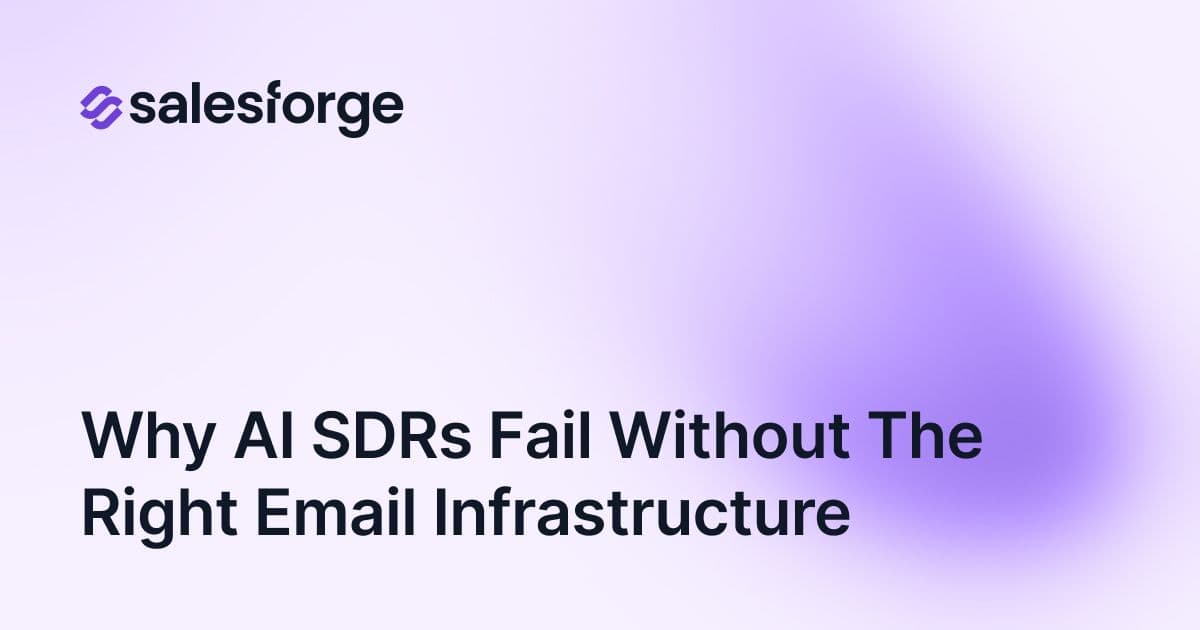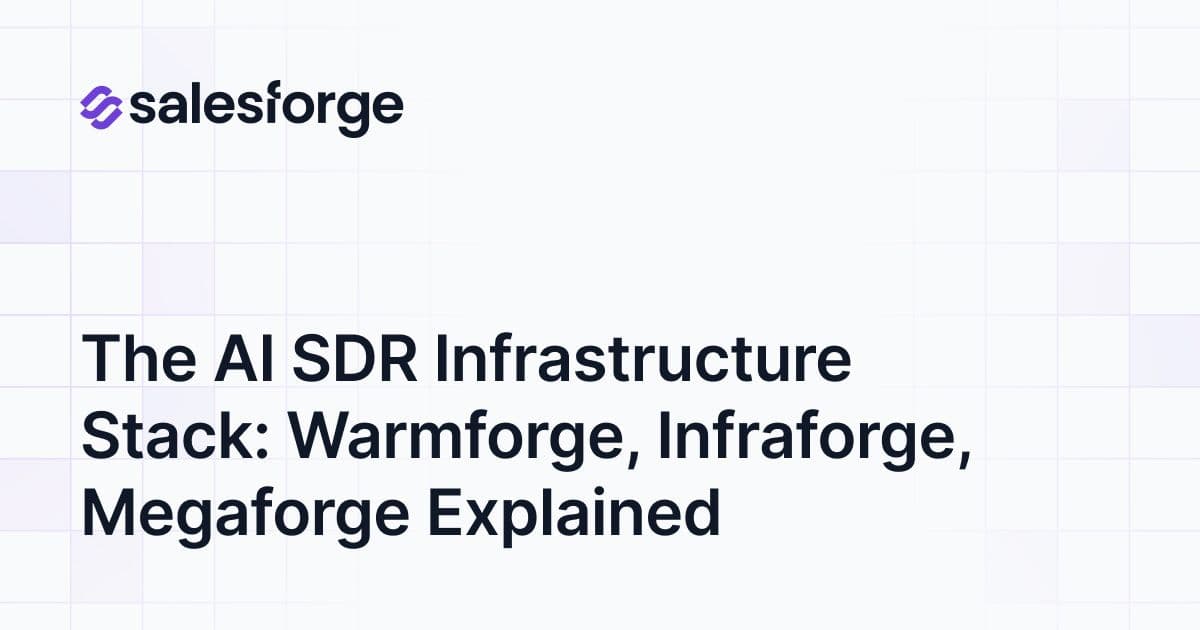Why AI SDRs Fail Without the Right Email Infrastructure
AI SDRs (Sales Development Representatives) often fail not because their messaging or personalization is poor, but because their emails don’t reach the recipient’s inbox. The issue lies in email infrastructure - an overlooked yet critical factor. Without proper setup, even the smartest AI campaigns can be flagged as spam or blocked entirely.
Key Takeaways:
- Email Authentication Matters: Without SPF, DKIM, and DMARC protocols, emails are likely to fail deliverability checks.
- Warm-Up is Essential: Gradually increasing email volume builds trust with providers, reducing spam flags.
- ESP Diversification Reduces Risks: Relying on one email provider can lead to campaign disruptions due to rate limits, blacklisting, or downtime.
Salesforge’s Agent Frank addresses these challenges with tools like Infraforge for private email setups, Megaforge for multi-ESP redundancy, and Warmforge for automated warm-up processes. This infrastructure-first approach ensures AI SDR campaigns succeed by prioritizing deliverability and reliability over just improving AI-generated content.
How Poor Email Infrastructure Kills AI SDR Performance
AI SDRs send out hundreds of emails every day, but even the most well-crafted campaigns can fail if the technical groundwork isn’t solid. Email service providers are becoming more aggressive in filtering out bulk or suspicious emails, and this can spell trouble for AI-driven outreach.
While many companies invest heavily in perfecting the messaging capabilities of their AI systems, they often overlook the technical side of email delivery. Without a strong infrastructure, even the best AI-generated content can end up in spam folders. Let’s break down the key technical issues - like deliverability challenges and inadequate warm-up practices - that hinder AI SDR success.
Deliverability Problems: When Emails Land in the Spam Folder
One of the most common technical pitfalls for AI SDR campaigns is poor domain reputation. Companies often launch outreach efforts using new domains or domains without proper authentication, which immediately raises red flags with email providers.
To ensure email legitimacy, three key protocols are essential: SPF, DKIM, and DMARC. These act as the backbone of email authentication:
- SPF (Sender Policy Framework): Specifies which servers are allowed to send emails on behalf of your domain.
- DKIM (DomainKeys Identified Mail): Adds cryptographic signatures to verify the integrity of your emails.
- DMARC (Domain-based Message Authentication, Reporting, and Conformance): Instructs receiving servers on how to handle emails that fail authentication checks.
Without these protocols properly set up, even personalized emails are likely to be flagged as spam.
Shared IP addresses add another layer of complexity. Many companies unknowingly use shared email servers, meaning they’re impacted by the reputation of other businesses using the same IP. If one company on the shared IP gets blacklisted for spam, everyone else on that server suffers the consequences.
Another issue is sending velocity. When a domain that’s been relatively quiet suddenly starts sending hundreds of emails daily, it sets off alarms with email providers. These systems are designed to detect unusual patterns, and without a gradual ramp-up, your domain could quickly be flagged as a spammer.
The Warm-Up Problem: Gaining Trust with Email Providers
The process of email warm-up is often ignored, but it’s a critical step in building trust with email providers. Warm-up involves gradually increasing your email sending volume while maintaining positive engagement metrics over time.
New domains and mailboxes start with no sender reputation, making them highly vulnerable to spam filters. Providers like Gmail, Outlook, and Yahoo use machine learning to evaluate sender behavior, engagement rates, and complaint levels to assess trustworthiness. Without a proper warm-up, these systems default to treating high-volume senders as spam risks.
A successful warm-up requires a slow, steady increase in email volume paired with strong engagement signals. This means starting with small batches of emails sent to responsive recipients, then scaling up gradually while keeping open and click rates high. Unfortunately, many companies skip this step in their eagerness to fully deploy their AI SDRs, leading to poor deliverability from the start.
Manual warm-up can be tedious and prone to mistakes. Without expertise in this area, companies often create inconsistent sending patterns that harm their sender reputation. This is one of the main reasons why AI SDR campaigns fail before they even get off the ground.
Beyond authentication, a well-executed warm-up strategy is essential for building a solid sender reputation.
Single ESP Risks and the Need for Backup Options
Relying on a single email service provider (ESP) can leave AI SDR campaigns vulnerable to disruptions. If that provider faces rate limiting, blacklisting, or technical downtime, the entire outreach operation can come to a halt with no alternative in place.
Rate limiting is a frequent issue for high-volume senders. Email providers impose daily or hourly limits on sending, which vary based on factors like account reputation and history. If AI SDRs hit these limits, campaigns are forced to pause, creating gaps in outreach that hurt overall effectiveness.
Blacklisting is another risk. It can happen suddenly due to a spam complaint, a spike in bounce rates, or even an algorithmic error. Companies relying on a single ESP have no quick fix when this happens and may face delays of days or even weeks to resolve the issue.
Different email providers also have varying criteria for filtering emails. For example, Gmail might accept messages that Outlook rejects, while Yahoo might have entirely different rules. Using only one ESP limits the ability to optimize delivery based on these differences, leading to lower overall success rates.
Technical downtime with a single ESP creates predictable gaps in outreach. These challenges underscore the importance of a robust email infrastructure. Solutions like Salesforge's Agent Frank tackle these issues directly, ensuring smoother and more effective AI SDR campaigns.
<script>(function(d,u,ac){var s=d.createElement('script');s.type='text/javascript';s.src='https://a.omappapi.com/app/js/api.min.js';s.async=true;s.dataset.user=u;s.dataset.campaign=ac;d.getElementsByTagName('head')[0].appendChild(s);})(document,372145,'tu1or50rqqejh816h1cm');</script>
Agent Frank and Salesforge: Infrastructure-First Solution

Salesforge's Agent Frank combines advanced AI with a robust email infrastructure to ensure that AI-generated emails land in inboxes - not spam folders. It operates through three specialized modules: Infraforge, Megaforge, and Warmforge.
When setting up Agent Frank, users can either connect their own mailboxes or use Salesforge's infrastructure. This flexibility accommodates businesses of all sizes, offering solutions that range from straightforward setups to enterprise-grade email systems. These modules work seamlessly together to ensure every AI-generated email reaches its target.
Infraforge: Private Cold Email Infrastructure

Infraforge provides businesses with their own private cold email infrastructure, giving them full control over their email-sending environment. Starting at $33 per month (billed annually) for 10 mailboxes, Infraforge addresses common shared reputation problems by offering:
- SSL certificates
- Domain masking
- Multi-IP setups with dedicated IPs
- Automatic configuration of SPF, DKIM, and DMARC records for email authentication
This setup allows businesses to scale their email outreach without worrying about shared reputation issues or hitting sending limits.
Megaforge: Multi-ESP System for Reliable Deliverability
Megaforge reduces reliance on a single email service provider (ESP) by distributing emails across multiple platforms. Starting at $69 per month for 20 mailboxes, it enables users to send around 300 emails daily (approximately 15 emails per mailbox).
Megaforge integrates with multiple providers, such as Primeforge (Gmail, Outlook), Mailforge, and Infraforge, to create a diversified sending environment. If one provider encounters rate limits or deliverability issues, Megaforge automatically reroutes emails through other ESPs, ensuring campaigns remain uninterrupted. This fail-safe system is particularly useful for maintaining consistent email volume in high-demand AI-driven sales campaigns.
Warmforge: Automated Warm-Up for Increased Credibility

Warmforge simplifies the process of building sender reputation by automating the warm-up phase. Before launching full-scale outreach, Warmforge warms up connected domains and mailboxes over a two-week period to establish credibility.
This automated system eliminates the need for tedious manual warm-up processes. By gradually increasing sending volumes in a way that mimics natural email behavior, Warmforge ensures that new domains and mailboxes develop a strong reputation. It also monitors and adjusts sending patterns to maximize deliverability, a critical factor in ensuring emails reach recipients' inboxes.
Together, these modules form the backbone of Agent Frank, ensuring that even the most advanced AI-generated outreach campaigns are delivered consistently and effectively.
Why Deliverability, Warm-Up, and ESP Backup Plans Matter
The success or failure of AI SDR campaigns often hinges on three critical but frequently overlooked factors: deliverability, warm-up processes, and ESP (Email Service Provider) diversification. These elements play a crucial role in determining whether your AI-generated emails actually reach prospects or end up lost in spam folders. Addressing these areas is key to building a reliable email outreach strategy.
Deliverability: The Foundation of Effective Outreach
Email deliverability is the cornerstone of AI SDR performance. Even the most advanced AI-generated emails lose their impact if they never make it to the recipient's inbox. In 2023, a staggering 45.6% of emails were flagged as spam, and 70% experienced at least one spam-related issue.
Deliverability rates typically range from 80% to 95%, but the best providers consistently exceed 96%. That difference can be game-changing. For instance, if your AI SDR sends 1,000 emails daily, improving deliverability from 85% to 96% means 110 more emails landing in inboxes.
Major providers like Gmail and Outlook use sophisticated algorithms to assess sender reputation, authentication, and sending patterns. For example, Google limits spam complaints to just 0.3%, and HubSpot enforces a hard bounce limit of 5% while capping spam complaints at 0.1% (1 complaint per 1,000 emails). Proper email authentication - using SPF, DKIM, and DMARC - is non-negotiable. A great example is AcreValue, a farmland data analytics platform, which optimized its email authentication in 2025 and saw open rates skyrocket from 5% to 70%.
Next, let’s explore how a systematic warm-up process helps build a strong sender reputation.
Warm-Up: Establishing Trust With Email Providers
A structured warm-up process is vital for building trust with email providers. New domains and mailboxes start with zero reputation, and jumping straight into full-scale outreach can trigger spam filters immediately. A warm-up gradually increases email volume to mimic organic behavior, helping establish credibility.
Campaigns sent from warmed-up domains experience up to 90% fewer bounce rates compared to those sent from unwarmed ones. A warm-up period of at least 15 days is generally recommended before scaling outreach efforts.
"Mastering authentication is crucial for email marketing success. If email deliverability feels overwhelming, Omnisend's experts can guide you through the process to ensure optimal results."
– Desislava Zhivkova, CustOps Deliverability Team Lead, Omnisend
Monitoring is equally important during this phase. Marketers who regularly track deliverability and inbox placement are 22% more likely to describe their email programs as successful. This includes keeping an eye on authentication, running blocklist checks, and conducting inbox placement tests to ensure smooth operations across all domains and mailboxes.
ESP Backup Plans: Safeguarding Campaign Continuity
Even with strong deliverability and reputation, relying on a single ESP is risky. Outages, rate limits, or deliverability issues can bring entire campaigns to a standstill. To avoid this, over half of companies (54%) use multiple ESPs to reduce risk and maintain campaign continuity.
A diversified ESP strategy spreads email volume across platforms like Gmail, Outlook, and specialized outreach services. This approach not only protects against service failures and blacklisting but also improves inbox placement by matching the recipient’s provider.
"I've been using a couple of other email infra forges for over a year and have been pretty impressed with deliverability. Now I added Google mailboxes and been using them for months as one of the early adopters to spread the load of 10K+ emails/day over to more ESPs. Stellar deliverability on Salesforge and spam tests always come back green! Excited to spin up some Outlook accounts soon also!"
– Rahul Lakhaney
By distributing email volume across multiple platforms, businesses can scale their outreach without overloading a single system. For example, in 2025, 123Presets doubled their revenue by moving away from a single-platform approach, while Kate Backdrop achieved a 1:300 return on investment by running campaigns across multiple ESPs.
Maintaining additional mailboxes and domains in a warm-up phase provides an extra layer of security. If one system encounters issues like blacklisting, these backup resources ensure campaigns can continue without disruption. When managing high-volume AI SDR campaigns, having these safeguards in place is not just helpful - it’s essential.
Salesforge's Infrastructure Comparison
Running a successful AI SDR campaign hinges on having a solid email infrastructure. Salesforge places a strong emphasis on the foundation of email delivery, recognizing its importance for campaign performance. The platform’s design prioritizes critical aspects like deliverability, warm-up, and ESP backups, addressing challenges outlined earlier.
Salesforge combines three essential tools that seamlessly integrate with Agent Frank:
- Megaforge: This multi-ESP system spreads campaigns across multiple email providers, ensuring built-in redundancy. If one provider hits rate limits, emails are effortlessly rerouted to maintain smooth operations. Pricing starts at $69 per month for 20 mailboxes.
- Warmforge: A built-in email warm-up engine that boosts sender reputation automatically over a two-week period before outreach begins. The best part? It’s included at no additional cost.
- Infraforge: A private cold email setup that includes SSL, domain masking, and multi-IP provisioning. This service starts at $33 per month for 10 mailboxes.
Conclusion: Infrastructure-First Approach for AI SDR Success
When it comes to achieving success with AI-powered sales development representatives (SDRs), the bottom line is simple: strong email infrastructure matters just as much as the AI itself. Even the most well-crafted outreach campaigns won’t make an impact if emails get flagged as spam or blocked due to rate limits.
Salesforge’s solution, showcased through Agent Frank, highlights why infrastructure must take priority. Their three-pillar system - Megaforge for ESP diversification, Warmforge for automated reputation building, and Infraforge for private infrastructure control - tackles the technical hurdles that often derail AI SDR efforts. This isn’t just about having a safety net; it’s about creating an email delivery system that earns the trust of inbox providers.
Take Megaforge, for example. By leveraging multiple email service providers (ESPs) for just $69 per month (covering 20 mailboxes), campaigns can continue running smoothly even when one provider hits rate limits. Add to that Warmforge’s automated two-week warm-up process, which strengthens sender reputation at no extra cost, and you’ve got a system designed to ensure consistent delivery. Together, these tools turn common email challenges into opportunities for sustained success.
For sales teams aiming to scale with AI SDRs, the takeaway is clear: prioritize infrastructure first, then fine-tune your AI. Effective campaigns rely on careful infrastructure planning, automated reputation building, and fail-safes like redundant delivery systems. With these essentials in place, AI SDRs can finally live up to their potential, delivering scalable and personalized outreach that drives real results. Without a solid infrastructure, even the smartest AI will struggle to make it to the inbox. Salesforge’s infrastructure-first strategy ensures Agent Frank has the foundation needed to succeed.
FAQs
What email authentication protocols are essential for ensuring high deliverability in AI SDR campaigns?
To ensure your AI SDR campaigns achieve strong deliverability rates, setting up SPF, DKIM, and DMARC protocols is a must. These email authentication tools confirm your messages are coming from a legitimate source, which helps prevent them from landing in the spam folder.
- SPF (Sender Policy Framework): Verifies that the email server sending messages is authorized to do so for your domain.
- DKIM (DomainKeys Identified Mail): Uses a digital signature to confirm that the email content hasn’t been altered during its journey.
- DMARC (Domain-based Message Authentication, Reporting, and Conformance): Works alongside SPF and DKIM to define how unauthenticated emails should be handled, ensuring a consistent policy.
When these protocols are configured correctly, they build trust with email providers, boosting your chances of reaching your audience’s inbox and driving better campaign performance.
Why is email warm-up essential for building a strong sender reputation, and why do many overlook it?
Email warm-up plays a key role in establishing a solid sender reputation. By steadily increasing both the volume and engagement of your emails over time, you signal to inbox providers that your messages are credible and deserving of trust. This approach helps minimize the risk of your emails being marked as spam.
Despite its importance, email warm-up is often neglected because it demands patience and a steady effort before you can hit your full outreach potential. Skipping this step, however, can result in poor email deliverability and harm your sender reputation, which can severely impact the success of your campaigns.
Why is using multiple email service providers (ESPs) essential for AI SDR campaigns, and how does it improve deliverability and reliability?
When running AI SDR campaigns, using multiple email service providers (ESPs) is a smart move. It boosts the reliability of your email delivery and reduces the chance of interruptions. If one provider hits rate limits or faces downtime, your campaign can keep running smoothly by shifting emails to another provider.
This strategy doesn't just improve email deliverability - it also helps protect your outreach from being marked as spam. Tools like Megaforge handle this process automatically, spreading emails across several ESPs to maintain consistent performance and keep your campaigns running without a hitch.



